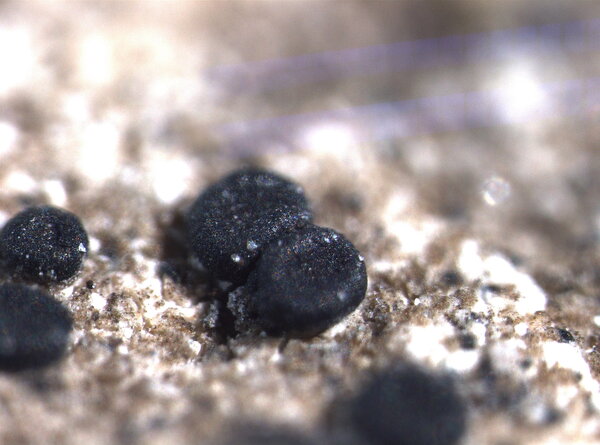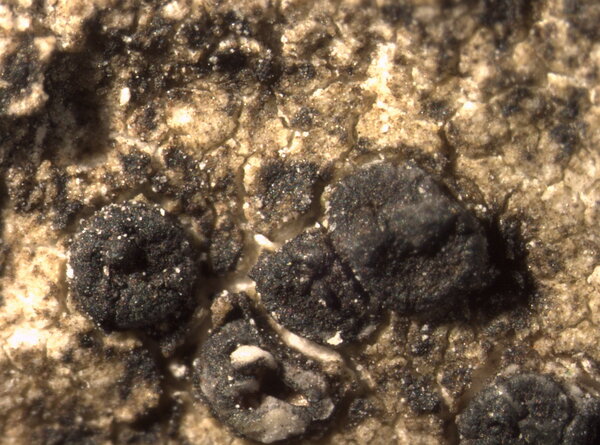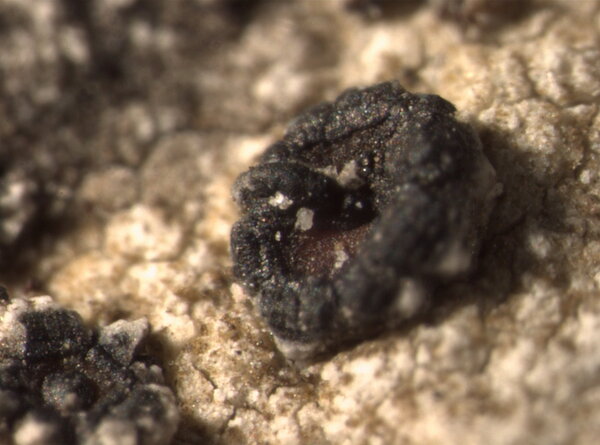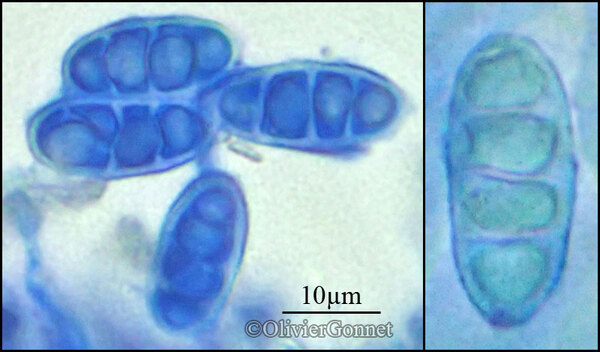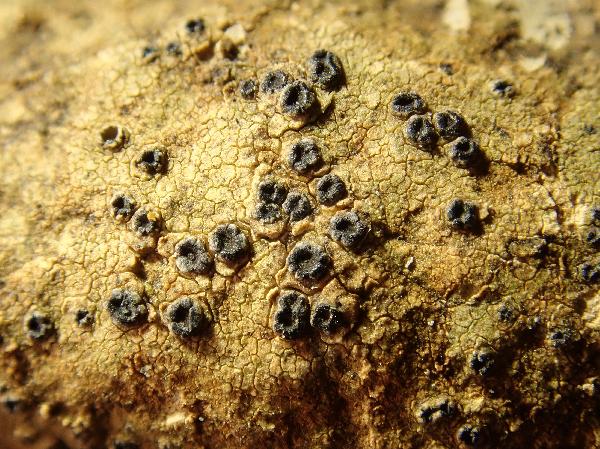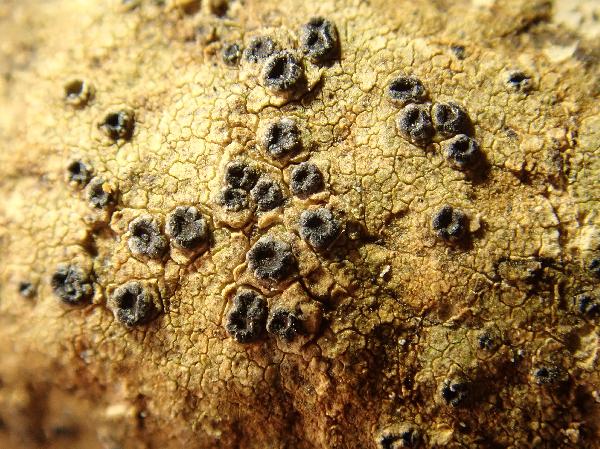Sagiolechia protuberans (Ach.) A. Massal.
Geneac. Lich.: 11, 1854. Basionym: Sagedia protuberans Ach. - Lichenogr. Univ.: 328, 1810.
Synonyms: Bilimbia protuberans (Ach.) A. Massal.; Gyalecta cimbrica (A. Massal.) Jatta; Gyalecta protuberans (Ach.) Anzi; Gyalecta protuberans var. mamillata (Hepp) Anzi; Lecidea protuberans (Ach.) Schaer.; Sagiolechia cimbrica A. Massal.; Sagiolechia leioplacoides (Vain.) Vain.; Verrucaria leioplacoides Vain.
Description: Thallus crustose, endosubstratic, continuous, wine-red when sterile, whitish, pinkish or pinkish brown when fertile. Apothecia (0.4-)0.5-0.8(-1) mm across, frequently arranged in lines or in clusters, at first largely immersed in the thallus, then sessile, black (the disc turning red-brown when wet), with an initially concave, then flat to convex, often umbonate to gyrose disc and a thick, radially split and sometimes finally star-shaped proper margin. Proper exciple black and carbonized in outer part, colourless to yellowish brown within, not extending below the hymenium; epithecium reddish brown to dark brown, K-, the upper part of umbo brown-black to black; hymenium colourless, 95-120 µm high, the hymenial gel I+ blue; paraphyses branched and anastomosing, c. 1 µm thick at mid-level, the apical cell swollen, up to 4 µm wide; hypothecium colourless to dark brown. Asci 8-spored, cylindrical to elongate-clavate, the wall K/I+ blue, the apical dome K/I-, Gomphillus-type. Ascospores (2-)3-septate, hyaline, ellipsoid to fusiform, (10-)12-25(-30) x (6-)7-9(-12) µm. Pycnidia black, immersed, the conidiogenous cells short, bottle-shaped, enteroblastic. Conidia acrogenous hyaline, bacilliform. Photobiont trentepohlioid. Spot tests: thallus K-, C-, KC-, P-, UV-. Chemistry: without lichen substances.
Growth form: Crustose
Substrata: rocks
Photobiont: Trentepohlia
Reproductive strategy: mainly sexual
Commonnes-rarity: (info)
Alpine belt: extremely rare
Subalpine belt: extremely rare
Montane belt: extremely rare
Dry submediterranean belt: absent
Humid submediterranean belt: extremely rare
Padanian area: absent
pH of the substrata:
1 2 3 4 5
Solar irradiation:
1 2 3 4 5
Aridity:
1 2 3 4 5
Eutrophication:
1 2 3 4 5
Poleotolerance:
0 1 2 3
Altitudinal distribution:
1 2 3 4 5 6
Rarity
absent
extremely rare
very rare
rare
rather rare
rather common
common
very common
extremely common
Loading data...
Occurrence data
Predictive map
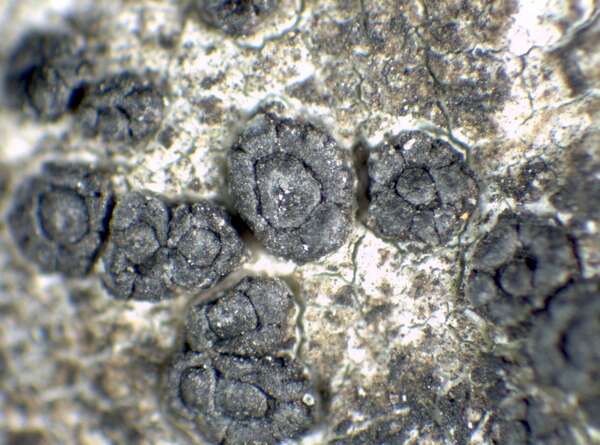
P.L. Nimis; Owner: Department of Life Sciences, University of Trieste
Herbarium: TSB (23717)
2001/12/18
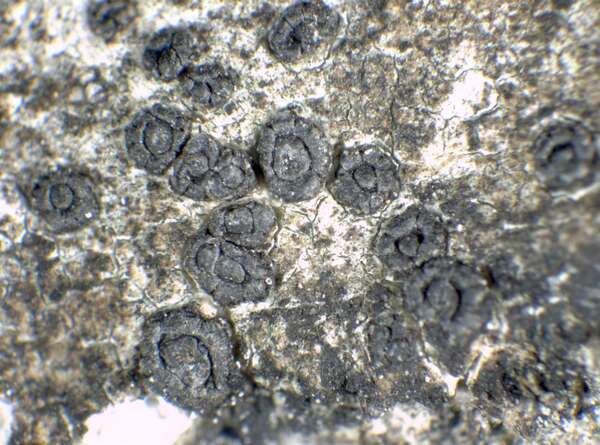
P.L. Nimis; Owner: Department of Life Sciences, University of Trieste
Herbarium: TSB (23717)
2001/12/18
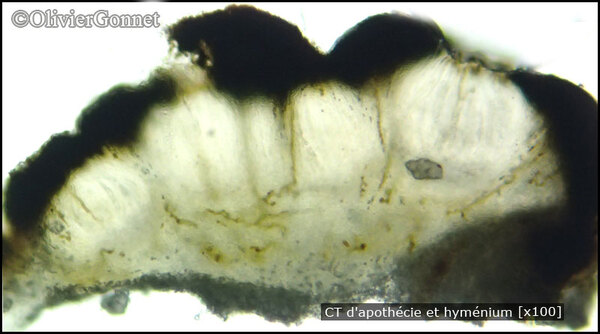
Courtesy Danièle et Olivier Gonnet - Source: https://www.afl-lichenologie.fr/Photos_AFL/Photos_AFL_S/Sagiolechia_protuberans.htm
France, 22/8/2016 - Ain
Growth form: Crustose
Substrata: rocks
Photobiont: Trentepohlia
Reproductive strategy: mainly sexual
Commonnes-rarity: (info)
Alpine belt: extremely rare
Subalpine belt: extremely rare
Montane belt: extremely rare
Dry submediterranean belt: absent
Humid submediterranean belt: extremely rare
Padanian area: absent
pH of the substrata:
| 1 | 2 | 3 | 4 | 5 |
Solar irradiation:
| 1 | 2 | 3 | 4 | 5 |
Aridity:
| 1 | 2 | 3 | 4 | 5 |
Eutrophication:
| 1 | 2 | 3 | 4 | 5 |
Poleotolerance:
| 0 | 1 | 2 | 3 |
Altitudinal distribution:
| 1 | 2 | 3 | 4 | 5 | 6 |
Rarity
absent
extremely rare
very rare
rare
rather rare
rather common
common
very common
extremely common
Loading data...
Occurrence data
Predictive map

P.L. Nimis; Owner: Department of Life Sciences, University of Trieste
Herbarium: TSB (23717)
2001/12/18

P.L. Nimis; Owner: Department of Life Sciences, University of Trieste
Herbarium: TSB (23717)
2001/12/18



